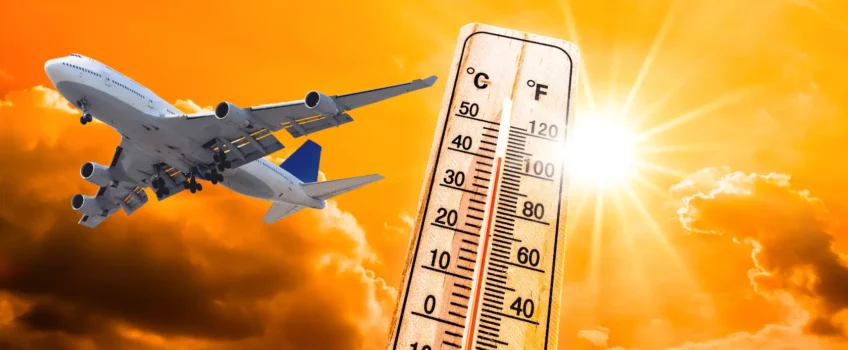
A clear, sunny day might seem like perfect flying conditions, but as temperatures continue to rise globally, the aviation industry is being forced to confront a new challenge: heatwaves. Soaring temperatures might feel nice on a beach, but they can present complex issues for aircraft. Let’s take a closer look at why this happens and some potential solutions to counter the effects of heatwaves.
The Physics Behind the Problem: Lift and Heatwaves
Airplanes rely on lift to take off, a force generated by the interaction of the aircraft’s wings with the surrounding atmosphere. The capability to achieve this lift is intrinsically linked to air density.
Paul Williams, a renowned professor of atmospheric science at the University of Reading, explains that as the air’s temperature rises, it expands. Fewer air molecules are present to provide the necessary lift, with the lift decreasing by 1% for every 3°C increase. In simple terms, when the mercury climbs, planes struggle more to leave the tarmac.
Where Heatwaves Hit Aviation the Hardest
Airports situated at high altitudes, or those with shorter runways, face the brunt of these challenges. Their naturally thinner air combined with lesser space for acceleration makes the balance even more delicate. If a plane requires 6,500 feet of runway at a pleasant 20°C, this requirement jumps to 8,200 feet when the thermometer shows 40°C.
Williams’ research provides even more food for thought. Examining data from 10 airports in Greece, renowned for their balmy summers and shorter runways, they found both a consistent increase in temperatures and a concerning reduction in beneficial headwinds – a phenomenon potentially linked to ‘global stilling’ caused by climate change.
According to scientists, global stilling is attributed to the rapid warming of the Arctic. This, in turn, reduces the temperature difference between the Arctic and the tropics, a disparity that fuels wind generation. Furthermore, studies indicate that global stilling has been persisting for decades.
The Real-world Impact on Passengers and Carriers
As these heatwaves intensify, they’re leaving tangible impacts. For instance, an Aegean Airlines Airbus A320, common at Greece’s Athens International Airport, has seen its maximum takeoff weight reduced annually. This essentially translates to one less passenger aboard every year. In 2018, London’s City Airport had to leave many passengers behind during a heatwave, ensuring the remaining ones could fly safely.
Furthermore, extreme cases in 2017 saw temperatures of about 49°C in Phoenix’s Sky Harbor International Airport, leading to numerous flight cancellations. Such events will likely become more frequent, with predictions suggesting major US airports could see significant weight restrictions during summer by 2050.
Possible Avenues for Adaptation and Solution
As the world grapples with intensifying heatwaves, the aviation industry is meticulously searching for solutions to ensure air travel remains as safe, efficient, and sustainable as possible. Let’s delve deeper into some of the viable adaptations and solutions the sector is considering.
1. Rescheduling Flight Times
The Early Bird Strategy: One of the more immediately practicable solutions involves shifting flight schedules. Instead of flights during the heat’s peak, airlines could favour early mornings or late evenings. This approach is already in practice in regions known for their extreme temperatures, like the Middle East, where avoiding the midday sun is both a cultural and logistical preference.
2. Engineering and Technological Innovations
Lightweight Aircraft: The drive towards crafting lightweight yet robust planes could alleviate some heat-related issues. Embracing materials such as carbon fibre for airframes not only reduces the overall weight but also enhances fuel efficiency.
Enhanced Aerodynamics: Aircraft manufacturers are increasingly exploring design changes that can help planes achieve the necessary lift, even in warmer conditions. This includes alterations in wing designs or even adjustments in engine performance.
“Hot and High” Aircraft Options: Some manufacturers, such as Boeing, have been offering enhanced versions of their popular models tailored for high altitude and high-temperature airports. These options come equipped with additional thrust and larger aerodynamic surfaces, compensating for any loss of lift due to the heat.
3. Infrastructure Upgrades
Runway Extensions: While certainly not feasible for all airports, especially those in urban locales, extending runways could provide the extra space needed for planes to achieve the necessary speeds for take-off in warmer conditions.
Improved Airport Facilities: This includes better cooling systems for both aircraft and ground staff, shade structures, and even advanced pavement materials that reflect more sunlight and absorb less heat.
4. Dynamic Weight Management
Optimised Cargo and Fuelling: Airlines can adopt smarter loading strategies, ensuring that aircraft are fuelled optimally, not necessarily to their maximum capacity, especially for shorter routes. This can reduce the overall weight, aiding in take-off during high temperatures.
Passenger Management: While not ideal, occasionally limiting the number of passengers, especially during extremely high temperatures, can be a necessary measure. This would ensure safety while retaining the aircraft’s efficiency.
Recommended: Top Aviation Innovations For A Sustainable Future
In Conclusion: Navigating the Heatwave Hurdle
Although current instances of passengers being offloaded due to heat remain relatively rare, the underlying message is clear: the aviation industry, along with the rest of the world, must adapt to the realities of a changing climate. Heatwaves are just one of the challenges, but they underscore the broader impacts of climate change on our daily lives and essential sectors.
Through a combination of smarter scheduling, aircraft engineering innovations, and infrastructure upgrades, the sector can hopefully mitigate these impacts and continue to transport passengers around the globe with safety and efficiency. That said, heatwaves are unlikely to be the last challenge faced by aviation in its mission to remain sustainable – thus, it is prudent that the industry continues on its path of innovation.
If you liked reading this article, please follow our weekly blog as we write about all things technology, engineering and manufacturing. For more information about what PRV Engineering does, visit the website or give us a call on 01495 769697.


 Mail:
Mail: 



